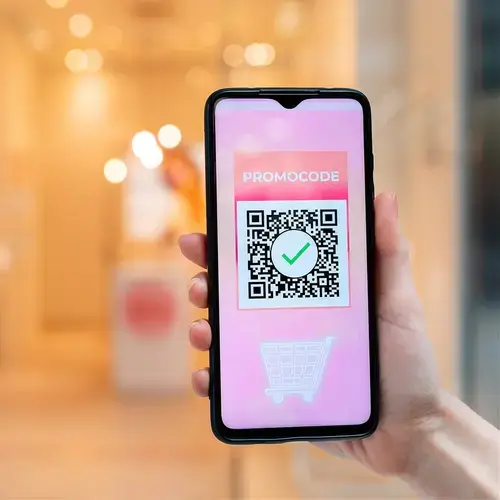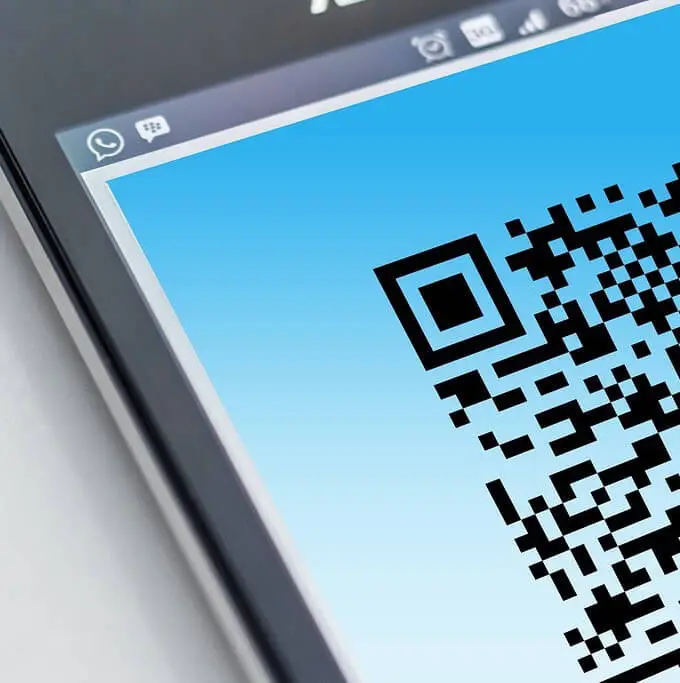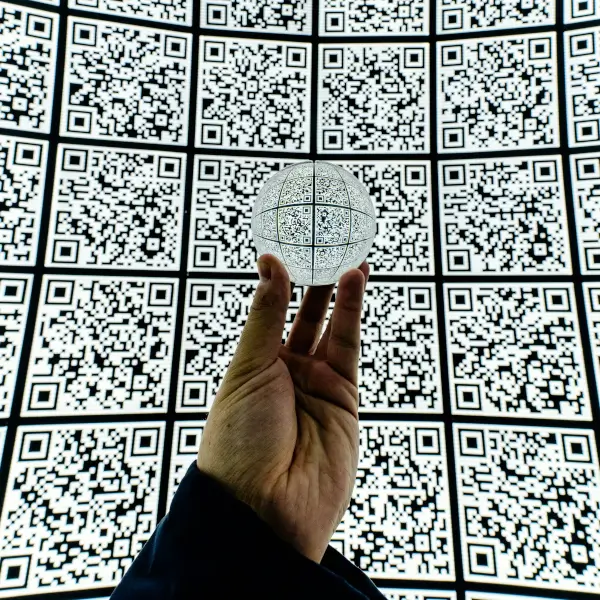Decoding QR Code Size: Minimum and Maximum Dimensions for Optimal Scanning
Quick Response (QR) codes, those ubiquitous black-and-white square symbols, seamlessly provide instant access to digital information with a simple smartphone scan. Their convenience has changed the way we access menus, make transactions, and more. But a QR code's effectiveness isn't just about what it holds. It's also about its size. Getting the dimensions right is critical to ensuring fast and accurate scans.

This article will address key questions to help you find the perfect balance in QR code sizing. How big does a QR code need to be? What's the practical limit on QR code size? Does a QR code have to be a certain size? By understanding these issues, you can optimize your QR codes for maximum effectiveness and ease of use.
Table of contents
- Factors Influencing QR Code Size
- 7ID: QR Code Generator & Storage App
- Minimum Size for QR Code
- Maximum QR Code Size
- Minimum Print Size for QR Code
- Scanning Distance
- Creating a Scannable QR Code for Posters
- Giant QR Codes
Factors Influencing QR Code Size
In the world of QR codes, not all are created equal, and their sizes range depending on their purpose and the complexity of the information they carry. Let's explore how these dimensions determine the optimal scanning experience.
The functionality of a QR code — what it does and the type of information it contains — plays a key role in determining its size. The QR code can afford to be smaller for simple tasks, such as directing users to a Web page or sharing a short piece of text. Such basic data takes up minimal space, allowing for a more compact design.
Complex data, however, ranging from detailed contact information to interactive experiences, requires a larger QR code. This increase in size ensures that each piece of information is accurately captured and conveyed.
The purpose of a QR code also plays a key role in determining its optimal size:
- When QR codes are used in marketing flyers or business cards, they must be prominent enough to catch the eye, but not so large as to overwhelm the design. Balance is key.
- On product packaging, space is often at a premium. QR codes need to be compact yet scan-friendly to provide additional product information or related websites without cluttering the package.
- QR codes on posters or large advertisements present a different challenge — they must be large enough to be easily scanned from a distance. This ensures that passersby can engage with the content without getting too close.
7ID: QR Code Generator & Storage App



Simplify your digital life with the 7ID App, the hassle-free solution for creating, storing, and scanning QR codes and barcodes right on your smartphone.
- Easily create a scannable QR Code and vCard. Fill your vCards with essential contact information, such as name, job title, phone, email, website, and social profiles — and turn them into shareable, scannable QR codes in a snap. Simply select 'Create QR', enter your details, add a catchy tagline, and hit 'Save'.
- Manage and store your QR codes or barcodes effortlessly. Think of 7ID as your digital vault, where all your important codes are safe and accessible even when you're offline.
- Scan QR codes and barcodes with ease. Open the app, point your phone's camera at a QR code or barcode, and let 7ID effortlessly capture and organize the data into your own digital library of QR codes.
- Go digital with loyalty cards. Scan your loyalty card barcodes once and enjoy instant access to your rewards and discounts without the hassle of carrying around countless physical cards.
Minimum Size for QR Code
Determining what is the minimum size for a QR code while ensuring it remains optimally scannable is a fine art. Let's take a closer look at what makes a QR code not only visible but effectively interactive.
How large does a QR code need to be to work? In general, for optimal scannability, a QR code should be at least 2×2 cm (0.8×0.8 inches), excluding the quiet zone.
Several factors affect the readability of small QR codes. Phone camera resolution is a key factor — higher resolution tends to capture details of a smaller QR code better. The contrast between the code and its background is also critical — the more contrast, the easier it is to scan, even at smaller sizes. In addition, simple codes can be smaller because there's less data to analyze.
Finding the ideal balance between a QR code's physical size and information density is a nuanced process. A QR code too small to scan can't hold enough information. On the other hand, unnecessary large QR codes can take up valuable space, especially in materials with limited space. The solution is to optimize the QR code to contain the essential information in the smallest practical size, ensuring smooth, successful scanning.
Maximum QR Code Size
Exploring the upper limits of QR code size is not just about a question of how big can a QR code be, but how its size affects its utility and user interaction. For example, when answering the question, “How big does a QR code have to be to scan?” we find that the larger the QR code, the greater the distance from which it can be successfully scanned. This is critical for marketing materials such as posters and banners that must attract attention from a distance.
Oversized QR codes unlock creative and functional potential. The increased size allows for embedding more complex information to be ideal for outdoor advertising or large spaces where close-up interactions aren't possible. This capability enriches marketing strategies, event engagement, and even public art, creating a connection to richer digital experiences.
As you can see, there is no fixed maximum QR code size. However, creating and scanning large QR codes can present challenges. First, there's the technical hurdle of creating a code that remains coherent and scannable at scale. In addition, factors such as distortion or physical blockage can affect readability. Other critical considerations include print quality and the scan distance required for optimal interaction. To successfully overcome these challenges, it's important to find the optimal balance in sizing QR codes to ensure they are easily scannable, readable, and secure.
Minimum Print Size for QR Code
Understanding the balance between a QR code's digital and physical dimensions is key to ensuring it scans correctly every time. The digital realm measures QR codes in pixels, with a sweet spot of at least 240×240 pixels (about 6.35×6.35 cm) and a clarity of 72 DPI (dots per inch). The largest QR code size, for example, is around 4,000×4,000 pixels. On the other hand, the physical world measures these codes in inches or centimeters with a standard size of QR code of at least 2×2 cm (0.8×0.8 inches) for optimal scannability, excluding the quiet zone.
But to answer the question “How big does a QR code need to be in print?” there is more to consider. Scanning distance affects the required size of a QR code. A useful guideline is the 10:1 ratio: the minimum size for QR code in print should be at least one-tenth the distance from which it will be scanned.
Readability depends on factors other than size. High contrast between the QR code and its background is essential, with black-on-white being a reliable choice. Print quality also affects readability; blurred or smudged QR codes are more difficult to scan. A clear “quiet zone” around the QR code, free of text, images, or other visual distractions, is also essential for easy recognition by scanners.
Wondering how to make a QR code smaller or bigger? Here is how to adjust the size of your QR code without sacrificing quality:
- Ensure that the size of the QR code correlates with the scan distance, using 10 times the size of the smallest element of the QR code for each meter of scan distance for optimal results.
- The high-resolution design ensures that QR code details remain sharp and legible when printed, regardless of size adjustments.
- It is critical to maintain a clear space around the QR code, even after resizing. This quiet zone is essential for scanners to operate effectively.
- After resizing, test the QR code with different devices and from different distances to ensure continued functionality. Size changes can influence clarity and readability, so testing is a critical step.
Scanning Distance
How far away can you scan a QR code? Surprisingly, QR codes don't have a one-size-fits-all scan distance. The general rule is the larger the QR code, the farther it can be scanned. This flexible scanning range ensures that QR codes can be adapted to different needs, whether it be up close on a business card or from several meters away on a billboard.
However, some factors can have an impact on the scanning distance. They include:
- Size of QR code: Larger QR codes can be scanned from further away.
- Scanner quality: The quality of the scanning device itself makes a big difference. Modern smartphones usually have no problem scanning QR codes from a distance.
- QR code complexity: A QR code with more data requires more scrutiny (literally), which affects scanning distance.
- Environmental factors: Lighting and the environment around the QR code can also influence readability. A bright, clear day works in your favor; a dimly lit room, not so much.
How far away can a QR code be read? The optimal scanning distance depends on the intended use of the QR code. For personal items (e.g., business cards, product tags) a smaller QR code works well, with an optimal range of a few inches to a foot, making it personal and intimate. For retail and information desks, medium-sized QR codes are ideal, maintaining a friendly scanning distance of about 1 to 3 feet (0.91 m), suitable for standing interactions. And large QR codes can engage audiences from 10 feet (3.05 m) or more away, making them perfect for posters, storefronts, and billboards.
Creating a Scannable QR Code for Posters
Wondering how to make a QR code for a poster? Let’s explore the best practices for designing QR codes on posters:
- Contrast is key: Use a QR code with dark colors on a light background to make it stand out.
- Keep it clear: Make sure there's a “quiet zone” around the QR code, typically about the width of a small square of the code on all sides.
- Strategic placement: Place your QR code where it's easily visible and accessible, ideally at eye level or slightly lower.
- Complement the design: The QR code should fit seamlessly into your poster design without being obtrusive or out of place.
For posters that will be viewed up close (e.g., in hallways, on bulletin boards), a minimum print size for a QR code is 1.2×1.2 inches (about 3×3 cm). Scaling up is critical for larger formats and viewing distances (e.g., outdoor advertising and trade shows). In this case, he recommended size for QR code starts at 4×4 inches (about 10×10 cm), with adjustments based on actual viewing distance.
When it comes to optimizing QR codes on posters, the testing stage is crucial. Simply do the following:
- Test your QR code with various smartphones and tablets to ensure universal scannability.
- Check the code's readability in different lighting conditions and distances to identify any necessary adjustments.
- Consider getting feedback from a small test audience on the QR code's visibility and ease of scanning. This input can be invaluable when making final adjustments.
- Use online resources to test and optimize your QR code for error correction and readability. Some tools even provide insight into scanning success rates and user engagement.
Giant QR Codes
Giant QR codes have become a new way to capture attention, deliver information, and create immersive experiences. Used in outdoor advertising, they grab the attention of passersby on billboards and buildings and provide instant access to promotional content. They encourage participation at events such as festivals and trade shows by providing schedules and exclusive content. Artists are incorporating these codes into installations that blend traditional and digital art, while in education, they connect users to rich resources and interactive lessons. These versatile technologies expand how we interact with information and experiences in public and educational venues.
When dealing with giant QR codes, keep in mind common challenges and considerations:
- Visibility and Readability: Ensuring that the QR code is both visible and scannable from a distance without distortion is critical. This requires careful consideration of code placement and size.
- Environmental factors: Outdoor elements such as lighting, weather, and physical obstructions can affect the readability of a giant QR code. It is important to choose locations and materials that mitigate these risks.
- Engagement strategy: Just being big doesn't guarantee engagement. The QR code must provide value to the scanner, such as exclusive content, discounts, or fun interactions.
Incorporating giant QR codes offers a unique way to connect with an audience, providing a blend of novelty and utility that can significantly increase engagement. One of the most popular examples of successful giant QR code implementations is a corn maze in the form of a giant QR code that links to the farm's website when scanned from the air. Another great example, more common in parks and nature preserves, is the placement of large QR codes along trails to educate visitors about the local history and ecosystem. As you can see, the possibilities for creating and using QR codes are endless.
In conclusion, the right QR code size is crucial for seamless scanning and user engagement. By balancing encoded data and intended use, you can create QR codes that are not only effective but also accessible across multiple areas of applications. Remember, the goal is to keep your QR codes functional, user-centric, and easy to scan, no matter where they're displayed.
Use 7ID to easily create, store, and manage QR Codes!
Read more:

QR Codes In Marketing: Creative Ideas for Business
Read the article
Facebook QR Code Generator: How to Use and Save on Phone
Read the article

